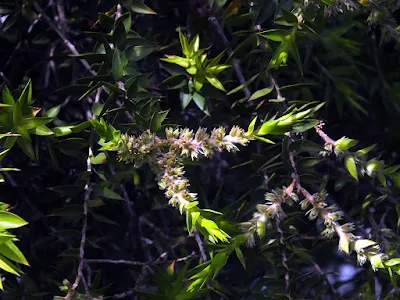Drouin appears to have two principal
species of street Paperbarks, the Prickly-leafed Paperbark, (Melaleuca stypheloides) and the Flax-leafed
Paperbark, (M. linarifolia).
 |
| M. linarifolia Lardner Rd |
 |
| M. stypheloides Lardner Rd |
There are a couple of hundred species of
Melaleucas and nearly all of them are endemic to Australia. The Swamp
Paperbark, M. ericoides, is the ‘wild’
species that can be seen in the wet gullies of the foothills throughout West
Gippsland. Melaleucas are close relatives to the Callistemons or Bottlebrushes.
‘Melaleuca’ means black and white,
referring to the appearance of the trunk at certain times, (or maybe the first
settlers saw the blackened lower half of the trunks after fire?). Melaleucas
are tolerant of dry and wet conditions but generally enjoy some periodic
inundation of their roots. They are good species for wet areas but their roots
are renowned for entering sewerage lines and drains.
 |
| Church St |
Paperbarks make good street trees for their
ability to tolerate pruning and if there is sufficient moisture in the soil,
they can be deep-rooted, allowing grass to grow right up to their trunks.
 |
| Tolerant! |
At the moment, Drouin’s M. linarifolia are in flower but the M. stypheloides are yet to flower fully.
Understandably, one common name for the Flax-leafed Paperbark is ‘Snow in
Summer’. Paperbark flowers are high in nectar content and attract many species
of insects and birds. The dense foliage provides good roosting habitat for
birds and many ‘remote’ Paperbarks will often contain bird and possum nests.
 |
| M. linarifolia |
 |
| M. stypheloides not quite out yet |
Of course, Paperbarks are named for their
obvious bark which can often provide cover for various insects, spiders and
reptiles.
 |
| M. stypheloides |
There are many ‘versions’ of Paperbarks now
propagated in nurseries and it is not difficult to select a variety to suit
most gardens. “One man’s weed is another’s wildflower” – introduced Melaleucas
have invaded huge areas of the Florida Wetlands!

No comments:
Post a Comment